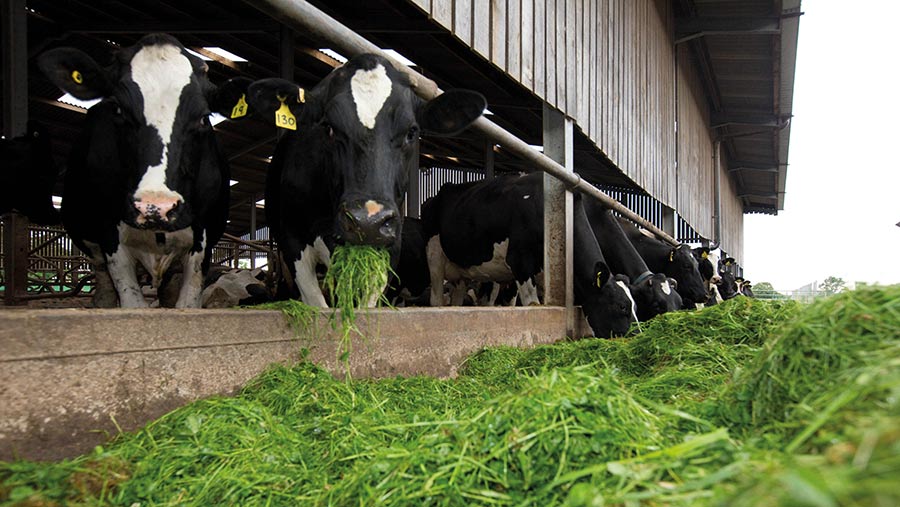Calving age and forage quality key to lower dairy emissions
 © Tim Scrivener
© Tim Scrivener Feeding good-quality forage and lowering age at first calving are two major steps farmers can take to help to lower greenhouse gas (GHG) emissions from dairy farming, while benefiting performance.
James Husband, head of livestock for data company Map of Ag, was sharing research at the TotalDairy conference held from 10-11 November 2021.
He explained that enteric and feed-related emissions make up about 70% of a dairy farm’s total GHG emissions.
Taking steps to limit these would fit with COP26 targets to limit global warming and the UK’s pledge to reduce methane emissions by 30% by 2030 compared to 2020.
Improving GHG emissions often also goes hand in hand with better farm financial performance, he says.
Modelling work carried out by Map of Ag highlighted the management changes that could help lower enteric and feed-related emissions (see “Potential effect of management changes on emissions” below).
See also: How livestock farmers can reduce greenhouse gas emissions
Forage quality and feeding system
Mr Husband says forage quality and reducing silage losses are “everything” when it comes to lowering emissions.
Dry matter losses will increase GHG emissions because the same amount of nitrogen is still being applied to the crop.
Ultimately, dry matter and protein losses as a result of poor clamp management mean more bought-in concentrate is needed, leading to a higher environmental footprint.
In a modelling example, a 100-cow farm producing high-quality forage rationed cows for maintenance +18 litres and had an average feed rate of 0.19kg/litre. Cows were fed to yield.
As a result, the herd produced 0.66kg carbon dioxide equivalent (CO2e)/litre enteric and feed emissions.
If the same farm fed average-quality forage and had an average feed rate of 0.3kg/litre, this increased to 0.75kg CO2e/litre.
However, the biggest impact came if the farm feeding this average-quality silage was not able to target-feed concentrate and was feeding a total mixed ration to a single group of cows.
Low-yielding cows would be eating more than they needed, leading to an average feed rate of 0.41kg/litre and a 10% increase in enteric and feed emissions to 0.83kg CO2e/litre.
This might be acceptable if the farm had a good milk price. However, if the herd also had poor fertility, it would quickly become unviable.
This is because there would be more cows at the end of lactation and probably more dry cows, leading to 0.92kg CO2e/litre from enteric and feed emissions.
Phil Garnsworthy, professor of dairy science at the University of Nottingham, says that feeding younger, leafier grass, whether grazed or conserved, will help lower methane emissions.
This is because methane is produced from the digestion of cellulose, and leafier, younger grass has less cellulose and more sugars. This results in lower methane production when eaten by the cow, and more digestible protein.
Age at first calving (AFC)
Calving at 24 months of age is by far the most efficient in terms of enteric and feed emissions, according to Mr Husband. He says an 18-24-month-old animal produces 8kg CO2e/day.
He modelled a herd producing 30 litres of milk a cow a day.
If the herd had a replacement rate of 24% and increased AFC from 24 to 30 months, there was a 3.2% increase in kg CO2e/litre.
When replacement rate was raised to 36% there was a larger effect and increasing AFC from 24 to 30 months resulted in a 4.8% increase in kg CO2e/litre.
According to Professor Garnsworthy, there is scope for UK farmers to lower their replacement rate from an average 33% to a target of 25-20% by improving cow health and fertility.
This would reduce the number of replacement heifers needed on farm.
For example, a 100-cow herd with a 33% replacement rate would need two heifers for every cow.
However, only one replacement heifer would be needed for each cow if the same herd had a 25% replacement rate. This would also lower average herd methane emissions by about 21%.
“In modelling work, that cow lived longer, too,” he says.
“A 33% replacement rate means a cow lasts three lactations; a 20% replacement rate means a cow lasts five lactations.
So, you spread that cow’s heifer [rearing] costs – whether that’s feed or methane – over longer and you need fewer replacements.”
Potential effect of management changes on emissions |
|||
|
Farm A |
Farm B |
GHG decrease |
|
|
Calving interval |
420 days |
365 days |
2.8% |
|
Age at first calving |
30 months |
24 months |
3-4% |
|
Forage quality, losses and feeding system |
Average |
Excellent |
10-20% |
|
Clinical mastitis |
40% |
20% |
1% |
| Source: Map of Ag | |||
